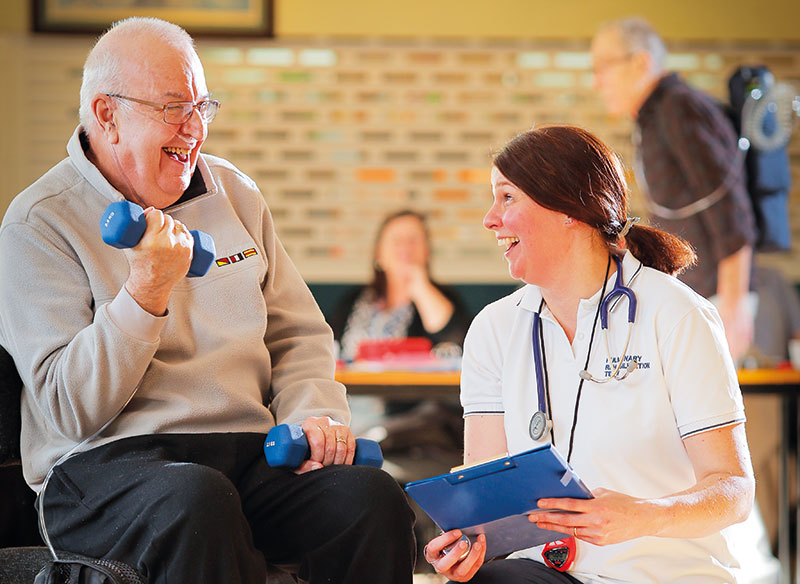 Making sure home is a safe place
Making sure home is a safe place
Making sure people are safe when having oxygen therapy at home was at the heart of a project by the Specialist Respiratory Team at Kent Community Health NHS Foundation Trust.
The team was already giving information and advice to patients and asking them to watch a safety film, but after a patient suffered facial burns due to smoking while using their oxygen, they decided they needed to do more.
The team agreed to create a leaflet, listing dos and don’ts, which people could keep visible and refer back to and since its introduction, there have been no further oxygen related facial burns incidents.
One patient who has benefitted is 70-year-old architect Alistair Scott.
He has praised the team as ‘some of the best people’ he’s experienced since becoming unwell, calling them ‘caring and very concerned to make sure you’re aware of everything.’
Alistair has needed oxygen therapy at home since February, after developing idiopathic pulmonary fibrosis. Having oxygen in his house means there is an increased risk of fire, but thanks to robust advice and information from the team, he feels well aware of what he should and shouldn’t do to stay safe.
Alistair said: “Members of the team came out and showed me how to use the machine, cylinders and tubing and gave me a leaflet with the dos and don’ts, as well as letting me know about a respiratory group I could join. They also arranged for two very helpful fire officers to come to the house who explained everything, fitted new smoke alarms and a heat alarm in the kitchen and advised us to put a sign on the front door to say that oxygen is in use inside.
“Being on building sites and looking after very old buildings and breathing in old dust might have caused me to become ill. Idiopathic means the cause is not known. I need the equipment as I struggle to breathe when my oxygen levels are too low and I get lethargic. Since becoming ill, I can still take Cooper, our dog for a walk, but it’s slower and on a flat path.”
Home oxygen therapy is prescribed for some patients who have low oxygen in their blood and need more oxygen than is available from room air alone. Patients may need to use a mask or nasal cannula tubing connected to an oxygen cylinder or device. Extra safety precautions must be taken when people have oxygen at home, as oxygen supports combustion and is a fire accelerator.
Advice includes removing oxygen from the kitchen 30 minutes before cooking, storing oxygen away from heat sources, using oxygen in well-ventilated rooms and keeping at least 10 feet (three metres) away from sparking objects, flames and extreme heat. People are told not to smoke or vape while using their oxygen, to cook or use power tools which may spark.
The Specialist Respiratory Team made improvements with the aim of reducing fire related incidents and to improve patient understanding of the risks, which as well as fire, also include tripping over tubing and equipment.
Respiratory Practitioner Frankee Nicholas said: “In addition to the robust oxygen risk assessments we complete, we felt that we needed a leaflet with a clear message to highlight oxygen safety dos and don’ts. We were already showing a fire safety video, but felt that just showing the video wasn’t enough, as patients may not always pay attention to this, or can easily forget afterwards, especially if they are on oxygen for a long time and we felt that a leaflet which could be given to patients would be beneficial."
Since the addition of the leaflet and other improvements, the number of oxygen related incidents has remained stable, with 14 reported over the past year, compared to 12 the year before. These incidents were related to falls and pressure damage caused by oxygen tubing and were thought to have increased due to increased colleague awareness to report such incidents.
Frankee added: "As patients are shown how to use oxygen equipment at home, they are warned of the risks and made aware of falls hazards which could be caused by tripping over tubing and equipment. An oxygen risk assessment is always completed prior to prescribing oxygen.
“As there have been no further oxygen related fire or burns reported, we feel that the leaflet is making a difference to this and generally improved our team’s understanding of the risks of oxygen therapy. It ensures we always go through the risks with the patient or care staff, if the patient is in a care home.
“The work is continuing on this constantly and we make sure all new colleagues learn about oxygen therapy and the safety side of it during training. The leaflet has been shared with our Pulmonary Rehabilitation Team so that they are able to use it too, as they often prescribe patients oxygen. It is also on the KCHFT website too, for any other clinicians who prescribes oxygen use.”




